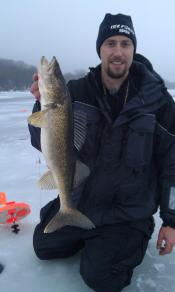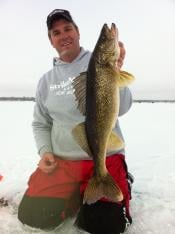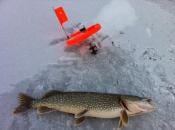 Strike up a conversation with someone about winter walleye fishing techniques and one of the first words that will often come up is finese. It’s not surprising considering we’ve all been pre-conditioned to think that walleyes, especially in winter, are as finicky as they come. OK, now take that notion, crumple it up into a little ball and throw it out the window!
Strike up a conversation with someone about winter walleye fishing techniques and one of the first words that will often come up is finese. It’s not surprising considering we’ve all been pre-conditioned to think that walleyes, especially in winter, are as finicky as they come. OK, now take that notion, crumple it up into a little ball and throw it out the window!
 Up until recently I had fallen victim to the same line of thinking… But it all changed a few winters ago when I decided to set a tip-up soaking a big sucker minnow in shallow near my favorite walleye location looking to catch a pike or two while I waited for the "primetime" walleye bite to begin. No more than 5 minutes had passed when I had my first flag and to my surprise landed not a northern pike but to this day my biggest walleye through the ice at 29 1/4". Was it a fluke? Let’s just say that no more than 15 minutes had passed before I iced my 2nd walleye on a sucker minnow, a healthy 26" piggie. I couldn’t have been more surprised. Shallow water? Daylight?? Sucker minnow??? Weeds??!! This isn’t how you’re supposed to catch walleyes!
Up until recently I had fallen victim to the same line of thinking… But it all changed a few winters ago when I decided to set a tip-up soaking a big sucker minnow in shallow near my favorite walleye location looking to catch a pike or two while I waited for the "primetime" walleye bite to begin. No more than 5 minutes had passed when I had my first flag and to my surprise landed not a northern pike but to this day my biggest walleye through the ice at 29 1/4". Was it a fluke? Let’s just say that no more than 15 minutes had passed before I iced my 2nd walleye on a sucker minnow, a healthy 26" piggie. I couldn’t have been more surprised. Shallow water? Daylight?? Sucker minnow??? Weeds??!! This isn’t how you’re supposed to catch walleyes!
 What I’ve found over the past few years of playing around with this approach is that not only was it not a fluke, but running big minnows under tip-ups can actually be one of the most effective early season techniques for icing huge walleyes and will often put more fish on the ice than any other approach. Even on days when the bite is slow there is something irresistable about a big minnow that hungry eyes just can’t turn down. Not only is this techniqe deadly along weedlines and shallow structure, but I’ve also found that suckers and big shiners under tip-ups can work equally as well in deeper water along sand/mud transitions or even out along the edge of the mud flats.
What I’ve found over the past few years of playing around with this approach is that not only was it not a fluke, but running big minnows under tip-ups can actually be one of the most effective early season techniques for icing huge walleyes and will often put more fish on the ice than any other approach. Even on days when the bite is slow there is something irresistable about a big minnow that hungry eyes just can’t turn down. Not only is this techniqe deadly along weedlines and shallow structure, but I’ve also found that suckers and big shiners under tip-ups can work equally as well in deeper water along sand/mud transitions or even out along the edge of the mud flats.
 Now don’t get me wrong, while it may seem simple yet effective way to put fish on the ice there is actually a ton of fine tuning and thought that goes into how and where I set my tip-ups. As an example this past weekend we were fishing next to several other groups who were also running tip-ups and I’d say we had at least 5 times as many flags and even more hook-ups because of a few minor differences in our approach.
Now don’t get me wrong, while it may seem simple yet effective way to put fish on the ice there is actually a ton of fine tuning and thought that goes into how and where I set my tip-ups. As an example this past weekend we were fishing next to several other groups who were also running tip-ups and I’d say we had at least 5 times as many flags and even more hook-ups because of a few minor differences in our approach.
The bottom line is that tip-up fishing can be an extremely effective weapon to add to any walleye fisherman’s arsenal and when it works it REALLY works! Tune in to FSN on Sunday to see just how effective early season tip-up fishing can be for big ‘Eyes!
A couple more photos from last week…
As you can see, we were also able to find plenty of success jigging but decided to focus on tip-ups as the windows when fish were aggressively chasing a spoon were much shorter. Our best evening came while fishing a 20-25′ sand breakline on the North end where my dad and I managed a dozen eyes with 4 keepers in a 1 hr window from 4:30-5:30 PM. Color was very important as I started with my favorite silver/red slender spoon and only went 1 for the first 5 good marks on my LX-7 that stopped in to have a serious look… After that I switched to a green/gold, looking to mimic the schools of perch which were thick along shoreline breaks, and immediately connected with the next 3 marks I had on my screen.
The flats are also kicking out quite a few fish, with more keepers, with silver/red and silver/blue producing best. Stay along the bottom edge of the flats in 28-33′ during the day and move up to the top edge of the flats with glow spoons for the morning/evening bite
Good looking walters Will!
Great report Will
Will,
Can you expand on what “fine tuning” you did to have 5 times more flags than any other group? One hook rig? Quick strike rig? other?
Thanks for the great report.
Mike
I think there were two main reasons.
Instead of simply walking 50 ft away from the shack and drilling a hole for the tip up we spend extra time locating our tip ups exactly on the edge of transition areas for depth, weed edge, bottom composition, etc.
The biggest difference however I think was how our bait was being presented. A quick-strike rig in was getting hit much more frequently than a single hook set-up. After moving the tip-ups around didn’t change the difference in hits we determined that the trigger causing more hits was that the quick-strike rig was restricting the minnow’s movement causing it to stuggle erratically. Switching multiple tip-ups to quick-strike rigs and adding 2-3 large splitshots 6-8″ away from the hook for any tip-ups without a quick-strike turned them all into flag waving machines!
There will be a better explaination of how we were rigging them on the show
Nice looking fish James and Will! Good report and write up! I think that will have to tryed in the near future! Big bait= Big Fish… confidence to go out and try it…another story, but will have to now!! Thanks for sharing!
Good luck
Jake
X2! Looking forward to the show.
-J.
Great info Will. I never thought much about the struggling that a minnow would do on a quick-strike. I’ve always thought that a single hook rig would let the minnow swim more freely, but maybe that isn’t what they want sometimes.
Thanks again!
Exactly, you still want extremely lively bait, it’s just that you don’t want it to be able to swim away too easily when a walleye is staring it down. Another way to get a similar result is to bite half the tail off bigger minnows. Not that I’ve ever done that before…
Nice fish guys
Will do you tie your own Quick strike rigs! I saw a post a while back on your hooks?
Very nice Will!
Awesome! I told my dad about this write up and he’s gonna try out some of the tips today, pics to follow (hopefully)
Yes and its about as simple as it gets. Just take a 2′ section of 30# flourcarbin line and fold it in half then tie a quick square knot to create a loop at the center of your section of line. Now add two #2 or #4 VMC sureset treble hooks to each end of the line approximately 6″ from the loop. Finally tie a small crankbait snap to your tip-up leader and attach it to the quick strike loop
Good luck!
Awesome report Will…nice work!!!
Thanks!
Here’s the video from today’s show for those that might have missed it.